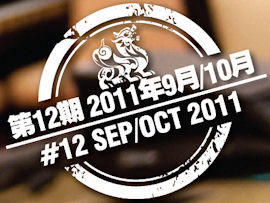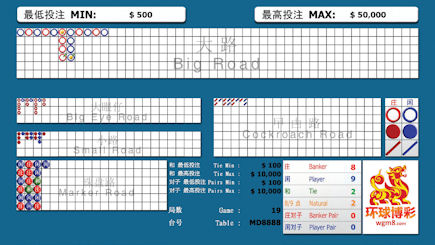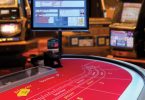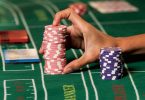This article first appeared in the Nov/Dec 2015 issue of WGM.
 Last issue we brought you a trip down memory lane to what was arguably the most talked about article we have ever run in the pages of WGM.
Last issue we brought you a trip down memory lane to what was arguably the most talked about article we have ever run in the pages of WGM.
“Fate in the cards: understanding baccarat trends” first appeared in our Jul/Aug 2011 issue and proved to be an article of particular significance as the first time baccarat’s complicated trends had ever been fully explained in English.
But given just how incredibly complicated these baccarat trends are, our original article was actually split into two parts with Part 2 first published in Sep/Oct 2011.
For those who missed it, you can read Part 1 by visiting www.wgm8.com. For the rest, we present “Fate in the cards: understanding baccarat trend Part 2.”
Enjoy – and remember you can find all our past issues and articles on our website, www.wgm8.com.
Welcome to the conclusion of our exposé on the mysterious art of following baccarat trends. Part 1 was the cover feature article of our Jul/Aug issue, and reading part 1 will give you a better understanding of part 2. If you don’t have a copy of our last issue, you can read part 1 (and every other article ever published in World Gaming) on our website wgm8.com.
Here’s a summary of what we learned in part 1:
- Most baccarat games use eight decks per shoe. This is enough for about 70 to 80 hands.
- Baccarat results were initially recorded on paper cards in a grid of six rows in height and indefinite width.
- Later a device known as the ‘bead plate’ or ‘cube tray’ was used. It is also six rows in height, and contains cubes which can show ‘banker’, ‘player’ and ‘tie’.
- These days baccarat tables in major casinos have electronic displays attached to them, showing all the information from the paper cards and the bead plate, and often more.
- Baccarat trends for each shoe are recorded on ‘roads’, which are pictorial representations of the results and trends of the shoe so far.
- There are five standard roads:
- The Big Road
- Big Eye Boy (sometimes called ‘big eye road’)
- The Small Road
- The Cockroach Road
- The Bead Plate (sometimes called ‘bead plate road’)
- Each road uses coloured symbols arranged in a rectangular grid of six symbols in height, and indefinite width.
- The big road and the bead plate directly record the result of the shoe so far. Big eye boy, the small road and the cockroach road (collectively called ‘derived roads’ or sometimes ‘predictive roads’) are much more complex.
- Normally the derived roads use symbols of half a cell’s height and width, so three rows of cells can fit six symbols vertically.
- The big road:
- A hollow red circle represents a banker win.
- A hollow blue circle represents a player win.
- The first banker or player result is marked in the top left corner of the grid. If the next result is the same, it goes under the first, and while the streak continues, circles of the same colour continue down.
- When the ‘other side’ comes up, a new column is started, so the big road becomes a series of columns of alternating blue and red hollow circles.
- Ties are displayed as a green line across the most recent circle.
- Multiple ties gives rise to multiple lines, or sometimes a small number next to the green line represents the number of ties.
- If a tie comes up before any banker or player result in the shoe, the green tie line is marked in the very top left cell in the grid, with the first circle drawn later in the same cell.
- Pairs are displayed with a dot on the edge of the circle (red dot for banker pair, blue dot for player pair).
- On some displays, natural winners are displayed with a yellow dot in the middle of the circle.
- If the road runs out of columns, it simply scrolls to the left.
- ‘Ping pong’ describes a run of alternating banker and player. Some players refer to a run of two bankers alternating with two players as ‘double ping pong’.
- If there are more than six consecutive bankers or players, the display turns right when it hits the bottom of the grid and continues along the bottom row, creating a pattern known as ‘the dragon’.
- If a streak bumps into a prior dragon, it immediately turns right creating a new dragon (sometimes referred to as a ‘double dragon’).
- The Bead Plate:
- Again red means banker, blue means player and green means tie.
- The first symbol appears in the top left corner of the grid and the road fills down vertically through all six cells of the column, moves to the second column and those six cells are filled in, and so on.
- Unlike the big road, ties occupy a cell in the grid.
- Derived Roads:
- They are not easy to immediately understand.
- They were invented in Macau after Casino Lisboa opened in 1970.
- It is said the ‘small road’ was invented by Mr Chan Kuen in the early 1970s, Lisboa dealer Chao Hon Mun (who had big eyes) adapted the small road in the mid 1970s to create a new road which became known as ‘big eye boy’, and later someone adapted big eye boy and the small road to create ‘cockroach road’, supposedly so-named by some junket agents.
- They are not a direct representation of the results of the shoe, but are derived from the big road and describe the patterns in the big road.
- They are made up of red and blue symbols: hollow circles for big eye boy, solid circles for the small road, and slashes for the cockroach road.
- IMPORTANT: The red and blue symbols that make up the derived roads do not correspond to banker or player. Red generally means there is a pattern, and blue generally means the shoe is ‘choppy’.
- There are no markings for ties, pairs or naturals.
- Due to the operation of the colour rules, the derived roads do not start at the very beginning of the shoe. Big eye boy, the small road and the cockroach road each start following the hand after the first hand in the second, third and fourth columns respectively of the big road.
- Once a derived road starts, an additional red or blue symbol will be added to that derived road after every hand.
- Derived roads follow the same column, dragon and scrolling conventions as the big road.
- Because the derived roads start later than the big road, the number of symbols in them will be less than in the big road. The differences for big eye boy, the small road and the cockroach road will be the number of symbols in the first column, first two columns, and first three columns respectively of the big road, plus one.
Now let’s move on to explain the colour rules, the prediction table and how players interpret the roads to determine what to bet on each hand, and how much to bet.
The colour rules for derived roads
Big eye boy, the small road and the cockroach road each show alternating streaks of red and blue, with a new symbol added to each derived road after each hand once the road has started. But how is the colour of the symbol determined?
This is very interesting, and quite complex. The best way to understand is to consider big eye boy first. Once you understand big eye boy, it’s quite easy to understand the small road and the cockroach road as they require only a minor adjustment. So let’s focus on big eye boy.
The rule for adding a symbol to big eye boy is different, depending on whether:
- The hand just played was entered in the first row in the big road, in other words it is the first hand of a new streak (I call this a ‘streak starter’), or
- The hand just played was entered in the second or subsequent row in the big road, in other words it is not the first hand of a new streak (I call this a ‘streak continuer’).
Streak continuers are easier to understand than streak starters, so let’s consider them first. There are three possible cases for streak continuers:
- The cell on the left of the streak continuer (in the big road) is full, which in Chinese is called 拍拍连, which literally means ‘clap clap connect’. In other words, the streak continuer is ‘connected’ to the cell on its left.
- The cell on the left of the streak continuer (in the big road) is empty, but the cell above that empty cell is full (in other words the streak continuer has now made the current streak precisely one hand longer than the previous streak). In Chinese this is called 一厅两房, which means ‘one lounge two bedrooms’. The term is logical: if you look at the four big road cells formed by a square, with the streak continuer in the bottom right corner of that square, there will be one circle of one colour in the top left position (‘one lounge’), and two circles of the other colour in the two right positions (‘two bedrooms’).
- The cell on the left of the streak continuer (in the big road) is empty, and the cell above that empty cell is also empty. This means the current streak is now at least two hands longer than the previous streak. In Chinese this is called 长庄 or 长闲, which means long banker or long player (depending on whether the current streak is banker or player). It doesn’t matter whether the streak is banker or player, the key factor is that it is long.
The colour rules simply state that for streak continuers (in the big road), the result of the next symbol in big eye boy is red for ‘connected’ and ‘long’, and blue for ‘one lounge, two bedrooms’. See figure 7 below (note figures 1 to 6 were in part 1 of this article).
![[b]Figure 7:[/b] Rules for determining the next colour to appear in 'big eye boy' upon appearance of streak continuers in the big road](http://www.wgm8.com/wp-content/uploads/2015/10/images_wgm_1012_Fate_in_the_Cards_7.jpg)
Note the colours of the circles in the big road are irrelevant, which is why they are shown in black instead of the usual red and blue.
Now you know the colour rule for streak continuers, you can learn the colour rule for streak starters. The colour to be added to big eye boy after a streak starter is simply the opposite colour to the one that would have been added had the previous streak continued. See figures 8, 9 and 10.
![[b]Figure 8:[/b] determining the colour of the symbol to be added to big eye boy after the first hand of a new streak – when the last symbol of the previous streak in the big road would have been 'connected' had the streak continued](http://www.wgm8.com/wp-content/uploads/2015/10/images_wgm_1012_Fate_in_the_Cards_8.jpg)
![[b]Figure 9:[/b] determining the colour of the symbol to be added to big eye boy after the first hand of a new streak – when the last symbol of the previous streak in the big road would have been '1 lounge, 2 bedrooms' had the streak continued](http://www.wgm8.com/wp-content/uploads/2015/10/images_wgm_1012_Fate_in_the_Cards_9.jpg)
![[b]Figure 10:[/b] determining the colour of the symbol to be added to big eye boy after the first hand of a new streak – when the last symbol of the previous streak in the big road would have been 'long banker' or 'long player' had the streak continued](http://www.wgm8.com/wp-content/uploads/2015/10/images_wgm_1012_Fate_in_the_Cards_10.jpg)
What about the situation when a streak starter immediately follows another streak starter? This is a ping pong situation. The colour of the symbol to be added to big eye boy for the first two symbols of the ping pong could be red or blue depending on the length of the two prior streaks, but once we get to the third hand and onwards in the ping pong, the symbol added to big eye boy must be red. As long as the shoe continues to ping pong, big eye boy will continue to be filled with a streak of red symbols. Given the colour rules explained above, you should be able to prove this ping pong result to yourself (hint: the answer is in figure 9).
Now you understand the colour rules for adding symbols to big eye boy, it is easy to understand the colour rules for adding symbols to the small road and the cockroach road. They are identical to the rules for big eye boy, with one fundamental difference. Under big eye boy, we always compared to the previous column to determine the colour of the next symbol. With the small road, we compare not to the previous column, but to the column before that. With the cockroach road, we compare to the column yet another column back. So big eye boy looks one column back, the small road looks two columns back, and the cockroach road looks three columns back.
The prediction table
Take a look at figure 12. At the very right there is a small table with the three blue and three red symbols. I call it the ‘prediction table’. Notice it has a red 庄 Chinese character (representing banker) and a blue 闲 Chinese character (representing player) at the heading of the columns. Under those characters are blue and red hollow circles (for big eye boy), solid circles (for the small road), and slashes (for the cockroach road). It just so happens that in figure 6 they are all blue under banker and all red under player, but they don’t have to be same colour each side. It can look like figure 11.
![[b]Figure 11:[/b] The prediction table](http://www.wgm8.com/wp-content/uploads/2015/10/images_wgm_1012_Fate_in_the_Cards_11.jpg)
The purpose of this table is to show what colour the next symbol in each of the three derived roads will be, given the result (banker or player) of the next hand. Note if the colour for the next symbol given a banker win is blue, then the colour for the next symbol given a player win must be red, and vice versa. Players can look at the trends in one or more of the derived roads, make a decision about which colour they feel will next occur in any particular derived road, and the prediction table tells them which side (banker or player) must win on the next hand to make that colour the one to be added to that particular derived road.
If any cell in the prediction table is blank, that means that that particular derived road has not yet started and will not start on the next hand. Remember the earliest hand big eye boy can start is the third hand, the earliest hand small road can start is the fourth hand, and the earliest hand cockroach road can start is the fifth hand, and if there are long streaks very early in the shoe the predictive roads may not start until considerably later.
Interpreting the roads
Having described how all five roads are created, how do baccarat players use them to determine their bets? There are as many different answers to that question as there are players, but some common themes exist in interpreting the roads and making betting decisions based on those interpretations. This is why you often see many players crowded around a baccarat table, betting on the same side (banker or player).
In the big road and bead plate, players tend to look for patterns and symmetry.
![[b]Figure 12:[/b] An example of symmetry in the big road, and a pattern in the bead plate](http://www.wgm8.com/wp-content/uploads/2015/10/images_wgm_1012_Fate_in_the_Cards_12.jpg)
Look at figure 12. On the next hand players might choose to bet banker which would make the big road perfectly symmetrical. Also note a pattern in the bead plate: the second last row is all blue. When the hand comes for the next column in that row players may bet on player, anticipating another blue symbol in that row. A player might also place a tie bet on the upcoming hand, anticipating a green symbol in the bead plate continuing the short line of green symbols already in the bead plate.
The derived roads are different. The general concept of these roads is that a lot of red indicates regularity in the big road, which gives it a feeling of predictability. For example, when there is a long streak in the big road (say a long dragon or alternatively a long streak of ping pong), all derived roads will show many red symbols.
If the big road is showing a regular repeating pattern, there will be red in one or more of the derived roads. If the repeating pattern is column-to-column, the red streak will appear in big eye boy. If the repeating pattern is column-to-two-columns-back, the red streak will appear in the small road. If the repeating pattern is column-to-three-columns-back, the red streak will appear in the cockroach road.
As a general concept, many red symbols in big eye boy, the small road or the cockroach road indicates a somewhat consistent big road.
Sometimes there are multiple repeating patterns in more than one derived road. Players often perceive these situations as particularly powerful, tending to bet more on a consistently repeating pattern that arises in all three derived roads than they would if the pattern is in only one or two of the derived roads. For example if the big road keeps going ping pong or a dragon, all three derived roads will show a lot of red and this could encourage players to bet heavily on the very clear pattern.
![[b]Figure 13:[/b] Examples of ping pong, a long dragon and general consistency in the big road](http://www.wgm8.com/wp-content/uploads/2015/10/images_wgm_1012_Fate_in_the_Cards_Part_13.jpg)
The opposite of this is the appearance of a lot of blue, which indicates ‘choppiness’. But consistent choppiness itself is a pattern that players may latch onto.
Players are also likely to place more faith in betting decisions where all three symbols (hollow circle, solid circle and the slash) are the same colour in each column of the prediction box, and that colour feels a likely result for the next symbol on each of the three derived roads. This feeling will usually come from some kind of pattern in the derived roads. For example figure 13 clearly dictates a bet next hand on player.
Baccarat trend following and the derived roads big eye boy, the small road and the cockroach road have been around for decades and there is no sign of them fading away. Originally a Macau phenomenon, they are spreading across Asia and the world. The next time you play and see those red and blue trails of symbols on the display, they won’t be such a mystery. Good luck at the tables!







